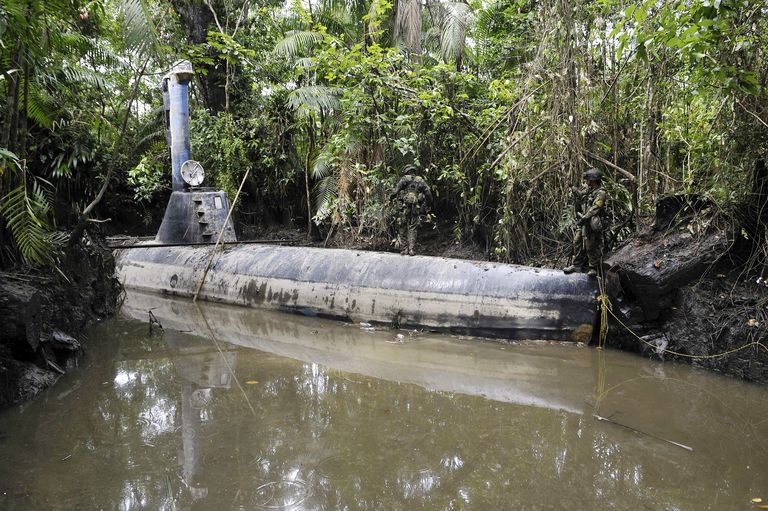The DIY Submarines Smuggling Millions of Dollars of Cocaine Into the U.S.
Smuggling, meet innovation.
Getty Images
Wet mangroves line the rivers that meet the
ocean along Colombia’s Pacific coast. The dense tropical canopy beneath
them makes for stifling heat—and the perfect cover from prying U.S.
satellites. For the past 25 years, drug smugglers have hidden entire
manufacturing operations beneath these trees. Not drug-manufacturing
operations—they’re making submarines. In the middle of the jungle. And,
for the first time ever, they’ve gone electric. Last summer, the
Colombian military captured a drug sub powered by smaller, quieter
electric engines and more than 100 batteries.
At the building sites, smugglers ferry in thousands
of pounds of materials, a labor force, and, sometimes, Russian
submarine designers. They construct subs up to 100 feet long, typically
made of wood, fiberglass, and Kevlar to avoid radar detection, and
capable of carrying as much as eight tons of cargo. Filled with cocaine,
that’s a street value of nearly $200 million. The subs themselves can
cost $2 million to build and often feature snorkels, radar, and
air-conditioned sleeping quarters for at least a captain, navigator, and
a guard. Although a few are built with twin hulls and periscopes to
allow them to submerge hundreds of feet, the majority travel just at or
beneath the surface of the ocean, their blue-gray paint camouflaging
them with the sea. To keep from showing up on thermal scans, some even
have lead-lined heat shields and exhaust systems that are routed
underneath the sub, giving the exhaust time to cool before it rises to
the surface.
According to the DEA, Colombia produced as much as
910 metric tons of cocaine in 2016, a 32 percent increase from 2015. By
some estimates, one third of that travels via these vessels. At a Senate
Armed Services Committee hearing in February, Admiral Kurt Tidd,
commander of U.S. Southern Command, estimated that the U.S. intercepts
only 25 percent of the drug subs coming to the U.S.—a number that has
not improved in years. The challenge, says Erik Soykan of the U.S.
Department of Homeland Security, is not only finding the subs. It’s
having someone close enough to catch them. “The subs are so low to the
water that it takes an airborne radar system to detect them,” Soykan
says. U.S. Customs and Border Protection has more than a dozen such
systems, but the area they must cover is vast: larger than the entire
United States. “When we do get them on the radar, we can track them,”
Soykan says. “The hope is that there’s an interdiction force on the
water that is able to intercept. There are many times when we know
they’re out there, and there’s just nobody there to go after them.
That’s frustrating.”
Sometimes the Coast Guard intercepts a sub only to
have the drugs disappear. Smugglers will drag an unmanned vessel behind
the main boat, 100 feet below the surface. Once discovered, they sink
the cocaine-stuffed drone so that another group can later track it on
encrypted transmitters, recover the drugs, and continue delivery. DHS,
Soykan says, is developing technology to fight drug subs and other
smuggling innovations. He just can’t talk about it. Much: “What I can
say is that there is technology out there that allows you to listen to
other radios. You put it on scan and listen to other people talking.”
It’s a constant cycle of technological one-upping. With no end in sight.



No comments:
Post a Comment